main: June 2007 Archives
Composer Adam Baratz, whom I've long corresponded with via Sequenza 21, and finally met this last month, has alerted me to two online texts well worth reading. One is the speech given by Peter Garland at the 1997 Henry Cowell centennial conference, which is posted at Other Minds. The passage in question is one in which Peter talks about Cowell's early piano pieces, and in which he, in one fell swoop, justifies even Cowell's simpler works as radical, outlines the philosophy underlying Peter's own gorgeous music, and demonstrates the derivation of his aesthetic from Cowell's. Of the early piano pieces, he says,
I think their simplicity is their strength, and the reason for their continued freshness. In this regard they share something with modern-day pop songs, in that relatively little information is conveyed, so that communication is immediate and right there on the surface. Many of the pieces have very simple, modal melodies, so the harmonic language is likewise very basic. I don't really take Cowell's justification of the tone cluster as the incorporation of the major and minor seconds into our harmonic/ melodic language along some sort of musical evolutionary line too seriously. Okay -- sure, fine. What blows me away about these pieces is that by compressing the interval relationships so tightly, they virtually cease to exist as such. So you are sidestepping the harmonic implications of the concept of interval, and what you are left with is: pure RESONANCE. That is the glory, the originality, the freshness of these pieces. By reducing melody and harmony to a background function, that of the simplest framework possible, one is affirming music not so much as a question of relationships, but rather of pure sounding and resonance. That is very radical, to me. One does not need to use tone clusters necessarily to achieve this effect. By severely limiting melodic and harmonic movement and by emphasis on repetition, the same effect can be achieved.
(Adam uses this as a personal motto for his own music.) I was present for the speech, but didn't remember this resounding passage. All I remember is that for 30 minutes Peter harangued us that none of us understood the real Henry Cowell - and that afterward we gave him a rousing standing ovation of several minutes' duration.
The other text just appeared this week in The New Republic, David Hadju's "The Breathtakingly Bad John Zorn," and as many of us don't subscribe to that journal, someone has finally posted the piece here. Rather than live up to its ferocious title, I find the piece rather even-handed, and I must say I find its conclusion about his music well-put:
Zorn is an exceptional artist, without question, because he prizes and seeks exceptionalism above all. This is not to say that he is exceptionally good at his art. What he is good at--so very good as to suggest a kind of genius--is being exceptional. Unfortunately, uniqueness is not an aesthetic value; it is a term of classification. To say that Zorn is one of a kind, as he certainly is, is to ignore the larger matters of his nature as an artist and, more significantly, the nature of his work, much of which is thin and gimmicky, and some of which is elementally corrupt.
Through his fiercely individualistic modes of working, Zorn deters attention to the work itself. He is obsessed with processes and systems, and he is often cavalier about their results....
The first music I heard by Zorn was Archery, in 1981, which sounded to me like Mauricio Kagel - whom I later learned had been an early influence on Zorn. The second was The Big Gundown, which appeared on Nonesuch in 1986, and which I found clever, genre-busting, and attractive. I've been waiting 21 years to hear something else of his I liked nearly as well.
I've never succeeded in getting my music on NPR, but I now have a relative who has. My brother-in-law Tim Cook has a CD of his harmonica playing, Lucy is the Guy with Diamonds, up on NPR's Open Mic site. For the last few years Tim's been living in northern Thailand at a Buddhist monastery, playing harmonica for the monks. (In Thailand, I could imagine that the line "Lucy is the Guy with Diamonds" might be more than just a Beatles parody.) Soon after Tim disappeared into the jungle - all we'd heard was that he'd headed for Thailand - the country was hit by the big Tsunami of December 26, 2004. No one heard from Tim for three months. I was scouring Thai-language web sites for names of known victims, and found two Tim Cooks, one from Australia, one from Austria. Finally, Tim phoned home, said, yeah, he was fine, just playing harmonica for the monks. You can listen to what the monks hear on NPR.
Though he never made his living as a musician, Tim was the clarinetist for whom I wrote my clarinet piece Dakota Moon and my clarinet quintet arrangement of Grieg's Wedding Day at Troldhaugen - played at my wedding, and never used since. Anyone wants a copy, I'll be happy to send score and parts.
Art Jarvinen, whose rhythmic intricacies are second to those of no one I write about, offers a different genealogy for how he came to metametric complexities. In ninth grade (circa 1971) he discovered Captain Beefheart & the Magic Band's then-brand-new album Lick My Decals Off, Baby, which he found, as he puts it, thoroughly "post-minimal/totalist, with the crunch that was supposedly added to the prettier pattern/phase things of Reich et al by my generation of composers." As evidence he sends an mp3 of the song "I Wanna Find A Woman That'll Hold My Big Toe Till I Have To Go," which you can listen to by clicking the link. Art didn't hear of Steve Reich till he got into college, and never heard the word phasing until his senior year, 1978, when percussionist Jan Williams lectured on the topic. By then, the metametric idea had already long been sown in him, via Captain Beefheart.
The idea of different-length loops running at the same time and going out of phase with each other, which I wrote about in the Totalistically Tenney post, is one I've been working with for more than three decades. It would be, if anyone knew much about my music, the idea with which I am most associated. I first used it in 1975 in Satie, my Opus 1, so to speak (here the loops are 11 against 19 against 6, as measured in 8th-notes, and the upper lines use a note-permutation technique that I later learned Jon Gibson and Barbara Benary were using as well):
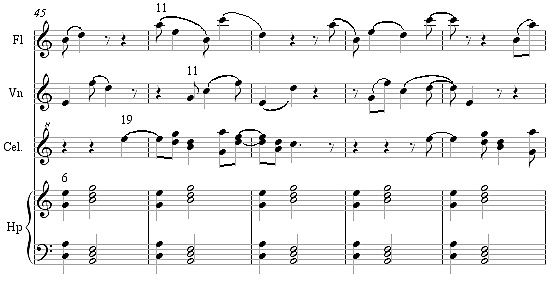
and most recently in Sunken City, the piano concerto I just completed (with indicated loops of 7, 5, 13, 11, 9, and 21 quarter-notes):
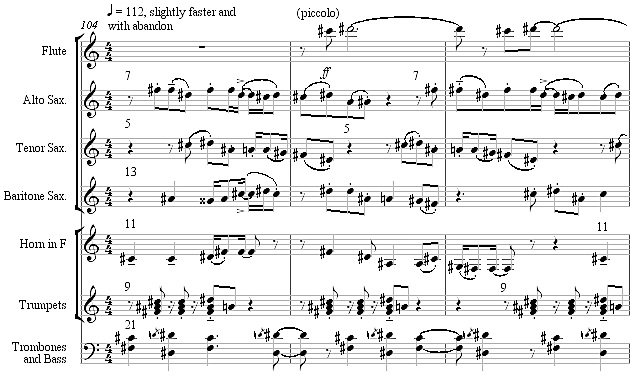
In between it's been the basis of perhaps half the pieces I've written, and the most characteristic half at that. Most people I mention my piano concerto to ask me if I retuned the piano. I guess everyone associates me with microtonality, but only about a third of my music is microtonal, including almost none of the acoustic music, and rhythm has always been more crucial to my music than pitch. I became electrified by microtones in 1984, but my fascination with polytempo goes back to 1969, the year I discovered Three Places in New England, and I have rarely written a piece in which the primary interest wasn't rhythmic.
And so much of my music uses repeated phrases of different lengths, played at the same time. The question is, what does it do for me? And even before that, what do I call the idea? I sometimes refer to my "nonsynchronous simultaneous loops," which is a horrific phrase; no antibiotic has so off-putting a moniker. I wish someone would come up with a name for my particular -ism, but I am reluctant to do so myself, even though I am far from being the only person to widely explore the idea. In any case, out-of-sync-loopism is not an inherently rewarding device. Unlike the gradual phase-shifting Reich discovered, it does not immediately arrest the ear. Unlike the 12-tone row, it does not offer any theoretical guarantee of deep underlying unity. In fact, it's a difficult idea to make work. As you can see from the first example, Satie, it's pretty easy to do if you want to float around in an unresolving, unchanging, pandiatonic cloud, which was the first solution I came up with. That much is easy, but it didn't satisfy me for long.
The idea of out-of-sync loops has many roots, all of them (so far as I know), American, although it would probably be possible to cherry-pick examples from The Rite of Spring. Henry Cowell implies the device in New Musical Resources, and momentary examples are common in Ives. Nancarrow's early music bristles with the device, especially Studies Nos. 3, 5, and 9; but I was already using it in 1975, and heard none of Nancarrow's music until the New World recording came out in 1976. The other root for the technique is easy to overlook: it is John Cage, for if you start a couple of loops repeating against each other, and agree in advance to accept whatever unforeseen clashes and unisons arithmetically result, that's much like accepting the results of a chance process. And it was originally a strong interest in Cage that made me willing to repeat a 31-beat melody against a 43-beat melody and be willing to accept whatever dissonances and consonances would eventually arise from their relatively unforeseeable combinations.
And so I've worked with the idea, and worked with it, and worked with it, and some of the attempts have been disastrous, others merely dull, and a few glorious. Blake's inspiring line, "If the fool would persist in his folly, he would become wise," has always been my motto, and I have exhibited a stubborn Scorpio persistance in my faith in this device that the consequences alone would never have justified. Set a bunch of repeating loops going, and certain uninteresting eventualities are virtually guaranteed. Take a loop of 11 beats against one of 13: in 143 beats they will have cycled through every possible combination, and unless you've calculated shrewdly, some of the results are bound to be awkward or redundant. In addition, the music is guaranteed to remain fairly static: the device generates ever-new combinations for awhile, especially if you have enough lines going, but the component materials themselves never change. A lot of the effect depends on what numbers you pick. Back in the '80s, I leaned on the Cagean aspect of the idea, with loops of 103 beats against 173 against 211 (all prime, of course), so that truly unplanned combinations would result. More recently, I use smaller numbers to create a more audibly pulsing texture, and play free and loose with harmonic alterations to ensure more surface interest.
Still, between the Scylla of unpredictable collisions and the Charybdis of predictably unvarying content, the out-of-sync loop device would seem to harbor more pitfalls than advantages. I have to ask myself, from time to time, why I keep trying to make it work; and I answer myself here, not only in the quest for self-knowledge, but because I'm giving a paper on this subject at a minimalism conference at the end of August, and I need to be able to explain not only why I but why other composers have been so fascinated by this problematic paradigm.
Number 1: it relates to some vague idea we all have of the medieval Music of the Spheres. Watching the 19-year cycle of the moon's orbit go out of phase with our revolution around the sun is a primordial human experience: too slow to observe on a weekly basis, but crucial for agriculture and calendar-making. The visible planets Mars, Saturn, and Jupiter also exhibit phasing relationships against the background of the stars, and the cycles of those planets (along with the invisible orbits of Uranus, Neptune, and Pluto) connect the nonsynchronous-looping idea with astrology. So looping at different rates has a deep philosophical connection with our experience of the moon and other planets. Certainly some of my interest in the idea was encouraged by all the grad-school work I did in medieval music, in which the Music of the Spheres was a potent theoretical paradigm.
Number 2: Looping segments of different lengths is one way to create a static musical texture without allowing any literal repetition. A couple of my pieces, like Windows to Infinity (1988) and Cosmic Boogie-Woogie (2000-1) employ the idea mechanically, and thus would eventually begin repeating literally if played for thousands of years. I am not much interested in literal repetition, but I am very partial to pieces that never stray from their opening premises. In some pieces I have learned how to use lines that inflect the harmony chromatically, so that the confluence of loops doesn't limit me to a static pandiatonicism. My favorite such passage is one in plain quarter-notes from Time Does Not Exist (2001) (with loops of 13 against 19 against 23):
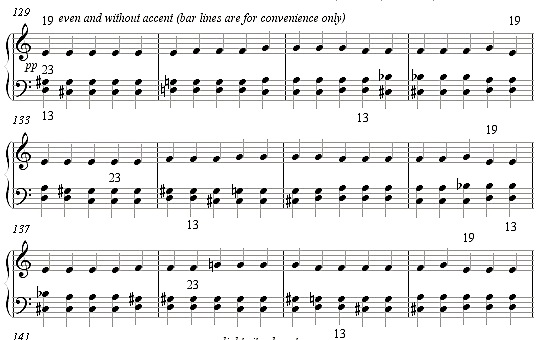
Number 3: It's a way to suggest the idea of different tempos at the same time in an ensemble context without actually asking people to play at different tempos. In the early '80s I was writing pieces (Long Night being about the only successful one) in which performers watched silent, blinking metronomes to play repeating phrases at different tempos. And of course, several of my Disklavier pieces, most notably Unquiet Night, use the idea with actual polytempos.
Number 4: It allows for a feeling of pulse, but destroys any overriding sense of regular meter. There is a vague sense of melodies, high notes, rhythmic motives, recurring; but since each line recurs at a different place with respect to the others at every repetition, there is a non-metric wash to the sound that, when it really works, I find rather ecstatically trancelike.
Number 5: Morton Feldman was inspired by the mobiles of Alexander Calder to write pieces in which various repeating motives float by one another in continually changing temporal relationships. Why Patterns? is a particularly clear example. As far as I know, all such instances in Feldman's music allow the players to play at their own rate, unsynchronized, so that exact relationships among the repeating figures are, in a detailed sense, unpredictable. Using repeating loops in a synchronized, metric context allows one greater control over the resulting relationships. There is, of course, no strong reason to maintain a mechanical rate of repetition, and in recent years I have sometimes only approximated the effect, conveniently avoiding unwanted clashes.
For me, these are potent philosophical, psychological, practical, and perceptual reasons to continue trying to make the idea work. It has often not worked, and (like Cage with his chance processes) I have often had to revise and revise until I liked the results. One of my best successes, I think, is in the last movement of Transcendental Sonnets, in which the entire orchestral texture (except for the climax about 3/4 of the way through) is pervaded by nonsynchronous loops, filtered through periodic changes in harmony; you can hear the result here. Every few years I seem to make some breakthrough to a more effective use of the idea. Out-of-phase loops can also be heard in Mikel Rouse's songs of the 1990s, and in Michael Gordon's pieces of the same period, like Yo Shakespeare (1993) and Trance (1995); and one can, of course, find similar ideas - usually with only the rhythms looped, and not the pitches - in the musics of John Luther Adams, Art Jarvinen, Joshua Fried, Diana Meckley, Larry Polansky, Evan Ziporyn, Eve Beglarian, Rhys Chatham, Glenn Branca, and others. I'm afraid I'm probably fated to keep working with the technique. It's like the speck of dirt that gets into an oyster, irritating him until he builds a pearl around it.
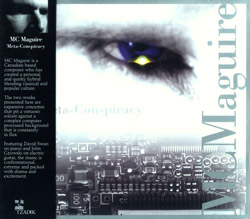 I promised you awhile back that I would let you know when M.C. Maguire's CD Meta-Conspiracy appeared on Tzadik, and I'm a couple of weeks late. It contains his piano "concerto" Short History of Lounge and his guitar "concerto" Got That Crazy Latin/Metal Feelin', both resplendently recorded. I put "concerto" in quotes, because these are pieces for solo instrument and envelopingly noisy electronic soundfiles. Compared to Maguire, Berg was a doodling improviser: these are stunningly complex works, built along the lines of astonishingly intricate tempo and tonal systems that govern most of the details. But they don't sound like that, for fragments of pop song weave in and out, and rock-style guitar riffs, and computer-voice messages, and everything but samples of the kitchen sink. I described the pieces better in my original post, and, as promised, I'm deleting Short History from my web site so as not to cut into Mike's (and Zorn's) sales. But it's one of the most astonishing CDs I've ever heard, not intended for the faint-hearted, and if you listen often and closely, you'll hear tempo and collage effects you've never heard before.
I promised you awhile back that I would let you know when M.C. Maguire's CD Meta-Conspiracy appeared on Tzadik, and I'm a couple of weeks late. It contains his piano "concerto" Short History of Lounge and his guitar "concerto" Got That Crazy Latin/Metal Feelin', both resplendently recorded. I put "concerto" in quotes, because these are pieces for solo instrument and envelopingly noisy electronic soundfiles. Compared to Maguire, Berg was a doodling improviser: these are stunningly complex works, built along the lines of astonishingly intricate tempo and tonal systems that govern most of the details. But they don't sound like that, for fragments of pop song weave in and out, and rock-style guitar riffs, and computer-voice messages, and everything but samples of the kitchen sink. I described the pieces better in my original post, and, as promised, I'm deleting Short History from my web site so as not to cut into Mike's (and Zorn's) sales. But it's one of the most astonishing CDs I've ever heard, not intended for the faint-hearted, and if you listen often and closely, you'll hear tempo and collage effects you've never heard before.
Can anyone explain for me these web pages of apparently computer-generated randomized sentence fragments, like this one, that almost all seem to contain the word "Blogroll" in the title? They seem mostly to be made up of bits of sentences from the daily news, with certain phrases occurring again and again, and "Kyle Gann on music after the fact" (which was Doug McLennan's coinage, not mine) is one of the ubiquitous phrases, along with several others from Arts Journal. They certainly gum up the search engines with nonsense, like the plaques that clog up the brain of an Alzheimers sufferer. I see nothing creative about them. They supply no delightful Cagean juxtapositions of hetergenous ideas, because the collection of phrases seems more or less equivalent on every page. They're just internet spam, as far as I can tell.
It's time for me to check out of the Betty Ford Center, the wing for recovering Wikipedia editors. I'm cured! I know because the Minimalism article over there is getting more and more misleading - and I don't even care! The opening paragraph now lists eight European minimalists and only four Americans, making it look like it was a predominantly European movement. Louis Andriessen is now a minimalist! And Gavin Bryars, and Steve Martland, and John Tavener! I have a score to Bryars's Four Elements next to me, which I don't have time or energy to quote here, but what's minimalist, I guess, is that its melodies are accompanied by repetitive arpeggios. Which means it's every bit as minimalist as this:

So that means Beethoven was a minimalist, too! And how about Holst's Planets? "Mars" and "Neptune" are certainly more repetitive than any Andriessen I've listened to lately. So geez, music history must be filled with minimalists! Of course, the new revisions are made by a Stockhausen scholar, to whom anything with a major triad in it must sound minimalist. But over at Wikipedia, he's the minimalism expert du jour.
The same scholar insists on a printed citation for the following sentence:
Its emphasis on accessibility, periodic rhythm, consonance, and pleasant and often even pretty sonorities drew millions of fans, especially among pop-music lovers, who had turned away from modern music, while simultaneously enraging many classical and academic musicians who saw it as a cheap throwback to a kind of mindless simplicity.
So what's the next editor supposed to do - run around and find books in which people insult minimalism and quote those insults? Or find a book which states that "many classical and academic musicians saw minimalism as a cheap throwback to a kind of mindless simplicity"? Or delete the sentence as unverifiable? I had written the above sentence to more objectively replace several nasty, nearly illiterate comments trashing the style (none of which had ever been asked for citations). But I don't care - it's not my responsibility! And it's been really good for me, because the time I might have wasted working on Wikipedia has been put into my book Music After Minimalism, which will offer clear, concise, well-documented definitions of minimalism, and its differences from postminimalism, that will stay put on the page, not alterable by anyone who chances along and decides that anything they think sounds minimalist, to them, must be minimalist.
Note to my students: No, you are not allowed to use Wikipedia as a source for class papers.
Everyone has web sites that he or she returns to compulsively in idle moments, and my new one, which I learned about from a comment on New Music Box, is the International Music Score Library Project at http://imslp.org/wiki/Main_Page, a rapidly growing collection of PDF scores from the entire history of music. (Unable to remember the cumbersome title, I've started thinking of it as "I'm-asleep.org.") You would imagine that the site would fill up quickly with Beethoven symphonies and Brahms chamber music, but actually the variety and the obscurity of the musical offerings are quite stunning.
My most exciting find so far has been the 36 Fugues, Op. 36, of Antonin Reicha (1770-1836), Beethoven's teenage-years friend from Bonn. Reicha professed unbelievably advanced (for the time) theories about music and about the fugue in particular. He advocated for odd meters; the 20th fugue is in 5/8 (with the subject answered at the tritone rather than the fifth), the 24th is in virtual 7/4 (4/4 alternating with 3/4), and another one in 3+3+2/8. They were written in 1803. Reicha ended up teaching at Paris Conservatoire, where Liszt and Berlioz were among his pupils, and sent his old friend Beethoven a copy of the fugues; old Ludwig tossed them aside with the comment, "The fugue is no longer a fugue." One of the fugues has simply a single repeated note as a subject; another is built on the theme from Mozart's Haffner Symphony, and their modulatory propensities are sometimes as striking as their rhythmic oddities. I've been fascinated by them since Tiny Wirtz's recording came out (the premiere recording) on CPO in 1992, and am astonished to suddenly find a score. (MDG has also released a charming and rather Czech-sounding Reicha orchestral overture in 5/8 meter. He also speculated about quarter-tones, long before Liszt and Busoni. The earliest explicit use of quintuple meter I can find, by the way, seems to be the mad scene in Handel's Orlando. One of the Obrecht masses has a passage with a repeating five-beat isorhythm, but of course there was no way to notate quintuple meter in that era.)
My first, 1997 Village Voice article about internet web sites was entitled "Weirdos Like Me," enthusing about the other crazy people who vomited forth their obscure passions on the internet, and many of those weirdos, it seems, are uploading to imslp.com. Here you will find a two-piano score to Max Reger's Piano Concerto (one of his most elephantine and least gratifying works, but one I've been trying to familiarize myself with lately); Arthur Foote's Piano Quintet, perhaps the finest chamber work of the American 19th century; Anatoly Liadov's lovely little high-register piano piece The Music Box; Busoni's wonderful Piano Concerto in a two-piano version, which a friend had finally bought me in Germany a few years ago; and Kaikhosru Sorabji's astonishingly forward-looking First Piano Sonata of 1919. I've now got the Concord Sonata in PDF form, as well as the Second and Sixth Nielsen Symphonies, and several early Dussek Sonatas for which I can find no recording. In recent weeks the number of scores expanded from 6000 to 7000 in only 20 days, and one of my favorite features is the "Recent Additions" on the main page, which I check daily to see what's been added. A couple of days ago I wanted to show a student an example from Holst's The Planets, without having to drive to my office for the score, and there it was.
Submissions are limited by copyright restrictions, as you can imagine, and so there are few recent works, and hardly any postclassical ones; though you will find In C and an intriguing flute and piano piece by electronic genius Chris Brown. Living composers are encouraged to add any works they are willing to release into public domain, or under a Creative Commons license. I toyed with the idea, but my available scores are easy enough to find on my web site for those who are looking for them. It's tempting to consider the people who might run across my pieces without imagining that they might find them at kylegann.com, but I am reluctant to relinquish so much control. So for now I'm not joining in the uploading frenzy, but I'm having a blast benefitting from it. The crazies who are releasing their eccentric music collections to the world have my immense gratitude.
I heard some music the other night in a loose improv style that, given a lot of more rigorous recent musical developments, I find a little old-fashioned. But I imagined myself going up to the performers and telling them that I had just finished a piano concerto, and thought I could do it with a straight face only if I were wearing a powdered wig and dipping into my Wedgwood ceramic snuff box. How old-fashioned would that have sounded? "I finished a piano concerto today" - it sounds as comically anachronistic as the sketch with which S.J. Perelman once opened a satire, in which a man comes home to his wife with the lapidary greeting, "Hello, dear, I just finished Hoover Dam." Yet my earliest musical memories are of piano concerti - Geza Anda's recordings of Mozart's K. 466 and K. 503, which my parents played while I was in the crib (they would lovingly quiz me on Köchel numbers) - and the genre is so imprinted on me that I've always expected to write one. Even though I scrupulously avoided thinking about sonata form, sonata touches crept in before I realized it - each movement contains an arguable point of recapitulation, and the first-movement recap picks up the exposition's ideas almost in reverse order, a Mozartean trick. Didn't plan it that way, but I listened, and that's where the piece wanted to go. (I keep waiting for someone to ask, "Wait a minute, you're a Downtown composer, and you're writing a piano concerto? What gives?" Then I'd have to admit that before I discovered Cage at 15, Copland, Harris, Bernstein, and Schuman had already seeped into my DNA, and that Composer Kyle is sometimes more Midtown than Critic Kyle likes to acknowledge.)
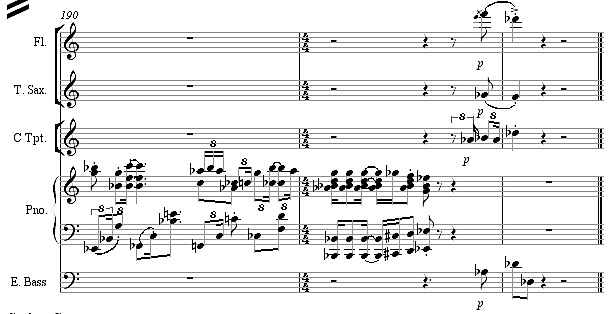
(End of the first movement)
In other Gannian news, I just learned that Philadelphia's Relache ensemble is planning to premiere my suite The Planets in its 75-minute entirety next May in Delaware, so I'm going to have a ton of music premiered in the coming academic year. (Not only Mozart, I can imitate Holst, too!) As I sink deeper into composing, I predict that my blog will become so introverted that eventually no one except my mother will continue reading. (Hi Mom! Thanks for the Mozart!)
I was subjected this morning to an NPR spot about André Previn's new solo jazz piano album. Excerpts I heard were sensitively played, I guess - but it was the kind of lusterless, easy cocktail piano that our best student jazz pianists can doodle out when they're not really thinking about it. Our jazz piano professor would play in that style only for satirical purposes. But André Previn is a famous musician, and of course famous musicians make only great music, and NPR can't risk wasting its audience's time with a musician no one's heard of....
Please forgive this intrusion of politics into a blog that has been exclusively musical lately, but a comment at The Carpetbagger Report, echoing a thought I had already had, deserves as wide circulation as possible. Democratic Representative William Jefferson has been indicted for corruption, and the meme of the day is that corruption in Congress is bipartisan - meaning Jefferson on the Democrat side, Cunningham, Ney, DeLay, Safavian, Libby, Griles, Foggo, Crawford, Foley, Korsmo and quite a few others on the Republican side. And pace those who still insist there's no significant difference between the parties, the Carpetbagger notes the respective reactions:
Even before the indictment against Jefferson was issued, congressional Democrats spoke out against him, distanced themselves from him, and removed him from power committee assignments. The Democratic leadership made clear they had no tolerance for Jefferson's alleged crimes, and pivoted off his indictment to introduce a massive new ethics reform measure.
And then there's the GOP. When Cunningham was exposed, House Republicans defended him. When DeLay was about to be indicted, they considered changing their own rules to let him stay in the leadership. When Ney was investigated, they stood by him. Indeed, the standard Republican strategy was to blame prosecutors, blame the media, make excuses, and defend the accused.
Even now, none of the current lawmakers facing criminal investigations have been ostracized for what appears to be a series of scandalous decisions, while most of the party wants a pardon (amnesty?) for a convicted felon caught lying and obstructing justice in the Plame leak scandal.
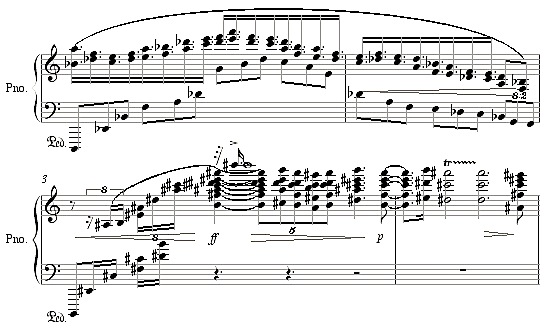
A playable draft of the 18-minute second movement of Sunken City, my piano concerto in homage to New Orleans, is completed. Now I have to go back and tackle the first movement's complex coda. The problem with composing, for me, is that once I start it pretty much ruins me for any more practical work. It's really not unlike drinking too much: once my head is absorbed in trying to figure out where the piece goes next, all quotidian matters, like e-mails I need to write, bills I need to pay, errands I need to run, fly out of my head and it's difficult to remember that I was supposed to do anything else. Even forgetting to eat is quite common; I realized an hour ago that I didn't have lunch today. So when I go into a composing period my life becomes very disorganized. If practical duties demand my attention, I basically have to take an entire day off from composing to do them, in which case I suddenly get a tremendous amount done. I'm just not the kind of artist, I don't believe, like Anthony Trollope or Philip Glass, who can get up every day, compose from 8 to 11 or whenever, and then cut it off and go about the rest of my life.
I do, however, have a natural cutoff point. At some moment between 2 and 4 PM, my composing mind turns off as abruptly as a spigot. I'll be working on a phrase and suddenly realize that I wrote four inelegant notes that make no sense and I don't know why, or I write three variants of something and have no idea how to choose among them, and I know I'm just done. My mind steps out of that fog in which I know how to make artistic judgments. Sometimes I can start composing again around 7 or 8 in the evening, if family or social life haven't intruded. In between my mind seems too sharply focussed. Peripheral vision perceives objects with a different kind of acuity than centrally focused vision, and I'm absolutely convinced something similar happens with the brain. But that still doesn't mean I can get much done between 4 and 7, because my mind is still racing around trying to solve whatever problem the day's work leaves me with. It's a wonderful feeling, and I love it, but it's extremely inconvenient.
Certain artists fall into creative patterns, but I believe there's a wide range of artistic working types, and that nothing can possibly work for everyone. I've read enough about left- and right-brain activity to attribute the difference to physiological variations. Men (generally speaking) have less fluid communication between their brain hemispheres than women do, for example, and I've long had a distinct impression that my left and right brain barely stay in touch at all. Alternating between talking (left brain) and playing the piano (right brain), for instance, is extremely difficult for me; I have to take that in account in my lecture style. If I play well and then immediately try to talk, I stumble trying to form sentences, and if I talk first it's difficult to lose myself in the music. And I gather that when I get into composing, I go into some kind of deep right-brain state, and making the transition back involves a painful effort.
Every artist has to figure out these patterns about himself, and it's more difficult because they change over the course of your life. When I was young, I wrote almost all my music between 11 PM and 4 AM, something I could never do now. It's very mysterious.
Stephen Colbert achieves what I can only dream of doing: out-talk my college president.
Sites To See
AJ Ads
AJ Blogs
AJBlogCentral | rssculture
Terry Teachout on the arts in New York City
Andrew Taylor on the business of arts & culture
rock culture approximately
Laura Collins-Hughes on arts, culture and coverage
Richard Kessler on arts education
Douglas McLennan's blog
Dalouge Smith advocates for the Arts
Art from the American Outback
For immediate release: the arts are marketable
No genre is the new genre
David Jays on theatre and dance
Paul Levy measures the Angles
Judith H. Dobrzynski on Culture
John Rockwell on the arts
innovations and impediments in not-for-profit arts
Jan Herman - arts, media & culture with 'tude
dance
Apollinaire Scherr talks about dance
Tobi Tobias on dance et al...
jazz
Howard Mandel's freelance Urban Improvisation
Focus on New Orleans. Jazz and Other Sounds
Doug Ramsey on Jazz and other matters...
media
Jeff Weinstein's Cultural Mixology
Martha Bayles on Film...
classical music
Fresh ideas on building arts communities
Greg Sandow performs a book-in-progress
Harvey Sachs on music, and various digressions
Bruce Brubaker on all things Piano
Kyle Gann on music after the fact
Greg Sandow on the future of Classical Music
Norman Lebrecht on Shifting Sound Worlds
Joe Horowitz on music
publishing
Jerome Weeks on Books
Scott McLemee on books, ideas & trash-culture ephemera
theatre
Wendy Rosenfield: covering drama, onstage and off
Chloe Veltman on how culture will save the world
visual
Public Art, Public Space
Regina Hackett takes her Art To Go
John Perreault's art diary
Lee Rosenbaum's Cultural Commentary
Tyler Green's modern & contemporary art blog
